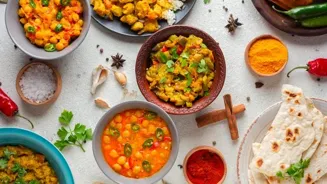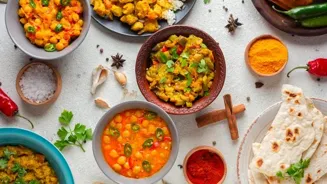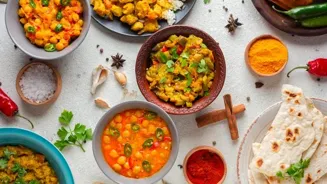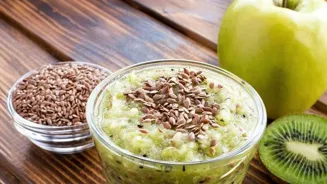Discover the fascinating world of Indian cuisine, shaped by diverse cultures and traditions. Unveil the secrets behind its exceptional diversity
India, a land of vibrant colours, diverse cultures, and ancient
traditions, boasts a cuisine as multifaceted as its society. Indian food isn't just about spices; it's a reflection of centuries of history, migration, and the beautiful blending of different communities.
From the snow-capped Himalayas to the tropical coastlines of the South, the culinary landscape changes dramatically. This article explores the unique factors that contribute to the exceptional diversity of vegetarian Indian cuisine.
Each region has its signature style, influenced by local ingredients, religious beliefs, and historical events. Be ready to unravel the secrets behind India's delicious and varied food.
Geographical diversity in India shapes food habits, ingredients used
The geographical diversity of India plays a crucial role in shaping its food habits. The fertile plains of the North, nourished by rivers like the Ganges and Yamuna, are ideal for growing wheat. This has led to a prevalence of breads like roti, naan, and paratha in North Indian cuisine.
In contrast, the South Indian states, with their abundant rainfall and coastal regions, depend heavily on rice as a staple. The hot and humid climate also favors the cultivation of spices like cardamom, cloves, and pepper, which are generously used in South Indian dishes.
The availability of fresh vegetables and fruits varies greatly across the country, influencing the dishes prepared in different regions. For instance, in Rajasthan, where water is scarce, dishes often incorporate dried lentils and beans, which can be stored for longer periods.
Coastal areas like Kerala and Goa use coconut extensively, reflecting the abundance of coconut trees in these regions. In mountainous regions like Kashmir, the cuisine is influenced by the cooler climate, with dried fruits and nuts being key ingredients.
So the geography not just influences the food habits but also dictates the ingredients used.
Religious influence on Indian food, emphasizing vegetarianism from Hinduism, Jainism, and Buddhism
The impact of religion on Indian food is immense, particularly when considering vegetarian cuisine. Hinduism, with its principle of ahimsa (non-violence), has contributed significantly to vegetarianism in India.
Many Hindu communities avoid meat and eggs, leading to the development of a wide range of vegetarian dishes. Jainism, another prominent religion in India, practices even stricter forms of vegetarianism.
Jains avoid root vegetables like onions and potatoes, as they are believed to harm small insects living in the soil. This has inspired unique culinary innovations, with ingredients like colocasia and yam substituting for potatoes and onions. Buddhism also has a strong influence.
Many Buddhists are vegetarian and promote a plant-based diet. Religious festivals also play a significant role in shaping food habits, many of them are associated with special vegetarian preparations that are unique to the region.
Religious restrictions on food have led to the creation of vegetarian options and culinary traditions.
Various empires shaped Indian cuisine with distinct ingredients and techniques
The arrival of various empires and cultures in India has left indelible marks on its food. The Mughals, originating from Central Asia, brought with them cooking techniques and ingredients that have become integral to North Indian cuisine.
Dishes like biryani and pulao, though often associated with meat, have excellent vegetarian options. The use of nuts, dry fruits, and dairy products like ghee and cream is also a Mughal influence.
The Portuguese, who colonized Goa, introduced ingredients like potatoes, tomatoes, and chili peppers to India. This last ingredient, in particular, has become an indispensable part of Indian cooking. The British, during their rule, introduced tea to India, which has now become a national beverage.
They also influenced the way Indians consumed certain foods, such as bread, which has become a popular breakfast item. The Persian empire too bought its influences of using dry fruits like raisins, cashew, almonds into the making of main course meals.
The interchange of ingredients led to the development of new dishes and flavors.
Social structure in India shapes diverse food practices
Social structure and caste system in India have contributed to the diversity of its food practices. Traditionally, certain communities were associated with specific occupations, influencing their diets.
For example, farming communities had easy access to fresh produce, leading to more vegetable-based dishes. The Brahmin community, traditionally priests and scholars, generally follow a strict vegetarian diet.
Over time, certain dishes have become associated with specific castes and communities, thus enhancing the diversity of regional and local culinary practices. Dietary customs also differentiated communities, enhancing the culinary diversity.
The hierarchical social structure fostered culinary traditions specific to each group. This has led to a rich variety of culinary practices, reflecting the diverse social fabric of the nation. These diverse social traditions also promoted the culinary diversity.
Movement of people shapes food habits globally, leading to fusion cuisine
The movement of people within and outside India has influenced food habits. As people migrate from one region to another, they take their culinary traditions with them. This has resulted in a exchange of food traditions.

Indian restaurants around the world have also contributed to the popularization and adaptation of Indian food. The diaspora has resulted in the fusion of culinary traditions. As people settle in new locations, they adapt their dishes to suit local tastes and ingredients.
This has led to the creation of fusion cuisine, blending Indian and international flavors. The exchange of ideas and ingredients amongst Indians, both at home and abroad, has enriched the culinary landscape. The blending contributes to the evolution and dynamism of Indian vegetarian cuisine.
Diverse cuisine reflects society, vegetarian options reveal culture
The diverse cuisine reflects a society shaped by geography, religion and culture. The vegetarian cuisine offers a unique glimpse into the cultural.
AI Generated Content. Glance/InMobi shall have no liability for the content








